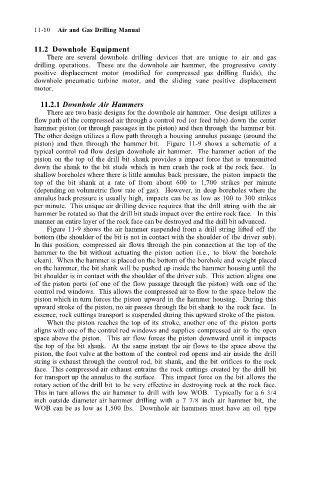Page 572 - Air and Gas Drilling Manual
P. 572
11-10 Air and Gas Drilling Manual
11.2 Downhole Equipment
There are several downhole drilling devices that are unique to air and gas
drilling operations. These are the downhole air hammer, the progressive cavity
positive displacement motor (modified for compressed gas drilling fluids), the
downhole pneumatic turbine motor, and the sliding vane positive displacement
motor.
11.2.1 Downhole Air Hammers
There are two basic designs for the downhole air hammer. One design utilizes a
flow path of the compressed air through a control rod (or feed tube) down the center
hammer piston (or through passages in the piston) and then through the hammer bit.
The other design utilizes a flow path through a housing annulus passage (around the
piston) and then through the hammer bit. Figure 11-9 shows a schematic of a
typical control rod flow design downhole air hammer. The hammer action of the
piston on the top of the drill bit shank provides a impact force that is transmitted
down the shank to the bit studs which in turn crush the rock at the rock face. In
shallow boreholes where there is little annulus back pressure, the piston impacts the
top of the bit shank at a rate of from about 600 to 1,700 strikes per minute
(depending on volumetric flow rate of gas). However, in deep boreholes where the
annulus back pressure is usually high, impacts can be as low as 100 to 300 strikes
per minute. This unique air drilling device requires that the drill string with the air
hammer be rotated so that the drill bit studs impact over the entire rock face. In this
manner an entire layer of the rock face can be destroyed and the drill bit advanced.
Figure 11-9 shows the air hammer suspended from a drill string lifted off the
bottom (the shoulder of the bit is not in contact with the shoulder of the driver sub).
In this position, compressed air flows through the pin connection at the top of the
hammer to the bit without actuating the piston action (i.e., to blow the borehole
clean). When the hammer is placed on the bottom of the borehole and weight placed
on the hammer, the bit shank will be pushed up inside the hammer housing until the
bit shoulder is in contact with the shoulder of the driver sub. This action aligns one
of the piston ports (of one of the flow passage through the piston) with one of the
control rod windows. This allows the compressed air to flow to the space below the
piston which in turn forces the piston upward in the hammer housing. During this
upward stroke of the piston, no air passes through the bit shank to the rock face. In
essence, rock cuttings transport is suspended during this upward stroke of the piston.
When the piston reaches the top of its stroke, another one of the piston ports
aligns with one of the control rod windows and supplies compressed air to the open
space above the piston. This air flow forces the piston downward until it impacts
the top of the bit shank. At the same instant the air flows to the space above the
piston, the foot valve at the bottom of the control rod opens and air inside the drill
string is exhaust through the control rod, bit shank, and the bit orifices to the rock
face. This compressed air exhaust entrains the rock cuttings created by the drill bit
for transport up the annulus to the surface. This impact force on the bit allows the
rotary action of the drill bit to be very effective in destroying rock at the rock face.
This in turn allows the air hammer to drill with low WOB. Typically for a 6 3/4
inch outside diameter air hammer drilling with a 7 7/8 inch air hammer bit, the
WOB can be as low as 1,500 lbs. Downhole air hammers must have an oil type

